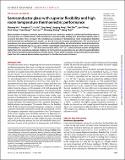Semiconductor glass with superior flexibility and high room temperature thermoelectric performance
Author(s)
He, Shiyang; Li, Yongbo; Liu, Lu; Jiang, Ying; Feng, Jingjing; Zhu, Wei; Zhang, Jiye; Dong, Zirui; Deng, Yuan; Luo, Jun; Zhang, Wenqing; Chen, Gang; ... Show more Show less
Download1.pdf (6.344Mb)
Publisher with Creative Commons License
Publisher with Creative Commons License
Creative Commons Attribution
Terms of use
Metadata
Show full item recordAbstract
Most crystalline inorganic materials, except for metals and some layer materials, exhibit bad flexibility because of strong ionic or covalent bonds, while amorphous materials usually display poor electrical properties due to structural disorders. Here, we report the simultaneous realization of extraordinary room temperature flexibility and thermoelectric performance in Ag2Te1–xSx–based materials through amorphization. The coexistence of amorphous main phase and crystallites results in exceptional flexibility and ultralow lattice thermal conductivity. Furthermore, the flexible Ag2Te0.6S0.4 glass exhibits a degenerate semiconductor behavior with a room temperature Hall mobility of ~750 cm2 V−1s−1 at a carrier concentration of 8.6 × 1018 cm−3, which is at least an order of magnitude higher than other amorphous materials, leading to a thermoelectric power factor also an order of magnitude higher than the best amorphous thermoelectric materials known. The in-plane prototype uni-leg thermoelectric generator made from this material demonstrates its potential for flexible thermoelectric device.
Date issued
2020-04Department
Massachusetts Institute of Technology. Department of Mechanical EngineeringJournal
Science Advances
Publisher
American Association for the Advancement of Science (AAAS)
Citation
He, Shiyeng et al. "Semiconductor glass with superior flexibility and high room temperature thermoelectric performance." Science Advances 6, 15 (April 2020): eaaz8423 © 2020 The Authors
Version: Final published version
ISSN
2375-2548